How To Play A Jazz Blues Chord Progression
In today’s free jazz blues chords lesson we’re going to take an in depth look at how to mix together some jazz chords and some blues piano chords into an incredible chord blend.
This combo of jazz and blues piano chords will make your blues sound way more interesting.
Players like Oscar Peterson, Wes Montgomery, Wynton Kelly, Bud Powell, Gene Harris, Ray Charles, and hundreds of other great jazz musicians made this blues chord progression famous.
If they played it then we should learn how to play it too! 🙂
So, let’s get starting learning this fun jazz chord progression for the piano. The best place to start is to watch the video first (video, free jam track, notation, and lesson below.)
Here is the chord chart for the 12 bar blues played in a normal way. You can also click on the chord chart to expand and print. (Bonus: Free Jam Practice Track at end of lesson).
Here is the chord chart for the 12 bar blues reharmonized with the jazz blues chord changes. You can also click on all the chord charts to expand and print them.
7 Tips To Understand This Jazz Blues Chord Progression
1. As we’ve talked about in this spread voicings lesson the #1 jazz chord progression is the II-V-I (2-5-1).
Most of the reharmonizations in this chord progression are just simply changing some of the regular blues chords and adding 2-5-1’s.
2. Don’t be intimidated by all these extra chords. Jazz musicians love to solo over the II-V-I chord progression.
Essentially, what we do is just set up important chords in the blues chord progression by playing a II-V right before hand. It makes the resolution chord more exciting.
3. For example, to set up the IV chord in measure 5 we play a quick II-V-I chord progression of the IV in bar 4. Gm7 C7 to F7.
4. In bar 9 and 10 instead of playing the normal V, IV, and I chords we substitute a II-V-I instead. Standard stuff 🙂
If you want to learn a fun lick to play over this check out this Bud Powell influenced lick, this Charlie Parker Lick, or this awesome Swingin’ II- V- I lick.
5. To got one step further we set up the Dminor7 chord in bar 9 by playing a II-V before that in bar 8 Emin7(b5) and A7. Here’s a minor lick you can play here.
6. Always keep in mind that a blues doesn’t have to be complicated. In fact it’s one of those simple chord progression piano sounds that can be dressed up or dressed down.
7. Speaking of dressing down, a blues chord progression, check out this basic 12 bar blues piano lesson to learn more.
Bonus Gospel Music Influence On This Chord Progression
8. In bar 6 the F#dim7 chord comes from the influence of gospel music. You’ll see the IV going to #IVdim7 and back to I in old school gospel piano chords regularly.
More Blues Piano Chords, Licks and Lessons
The intersection of jazz and blues is really a beautiful sound. There are so many great players who were heavily influenced by the blues and used it as a part of their vocabulary.
Since it’s so important I’ve created a short list of some additional resources for you to explore the blues.
If you want some actual blues licks to play over these chords you can check out this Oscar Peterson lick lesson. Oscar Peterson was a masterful blues player!
If you’re new to the blues sound in general than I also recommend you check out this free blues scale for piano guide. It’s a great place to get comfortable with the most important scale in blues.
It’s also a great scale to build blues piano licks from.
If you’re looking for chords to play over this chord progression then also check out this jazz blues comping chord lesson.
 If you want to learn more about authentic blues piano than I also recommend you check out the DVD Learning Chicago Blues Piano.
If you want to learn more about authentic blues piano than I also recommend you check out the DVD Learning Chicago Blues Piano.
Bonus: Here is a free jam track that you can use to practice this jazz blues chord progression. The track is in the key of C and features real samples of upright bass, drums, and percussion. Stretch out, learn, and jam.
Feel free to come back to the site regularly to practice. Enjoy!
If you have questions and enjoyed this blues progression piano lesson and free jazz lesson please leave a comment below. If you’re new here be sure to sign up for the free jazz lessons email list on the top left, right, or just below.
Easy Blues Piano Video Chords Tutorial
Want to learn some easy blues piano chords? You’ve come to the right place! In today’s free video lesson I’m going to show you how to play several great easy blues piano chords.
Take 5 minutes & watch the video below. Then, scroll down for important tips and resources to help taking your blues playing to the next level.
Being from Chicago, blues is really front and center in a lot of what we do. In fact, studying blues can make you a much better musician in many other styles of music.
 So, if you’re playing straight ahead blues blues (like I did on the B.B. King tours I played) or you’re playing jazz, gospel, rock, or R&B, there’s always a little bit of the element of the blues going on in what we’re doing.
So, if you’re playing straight ahead blues blues (like I did on the B.B. King tours I played) or you’re playing jazz, gospel, rock, or R&B, there’s always a little bit of the element of the blues going on in what we’re doing.
So, in today’s video I show you these great sounding blues block chords. These are easy blues piano chords that sound great and can be used in lots of different musical scenarios and styles.
So, you can use them in a traditional blues club, harmonizing a gospel hymn, and even in your jazz improvisation style. Now, lets learn more about how to do this…
7 Tips To Masters These Easy Blues Piano Chords
1.How To Play Interesting Chord Progressions Over The Blues
As we explore in The Breakthrough Blues Method course, there are lots of ways to play interesting blues chord progressions. For example:
- You can play the first 4 bars of the blues with just a C7.
- You can throw a 2 5 1 chord progression into the blues.
- You can throw a quick IV chord in on bar 2.
 In this video above, I show you an additional chord progression you can use for the first 4 bars of the blues.
In this video above, I show you an additional chord progression you can use for the first 4 bars of the blues.
And that chord progression in terms of music theory is I6, ii7, I diminished, I7, ivm6, bV7, and then it resolves to the IV chord in bar 5.
To put it more simply, in the key of C the 7 chords I use are.
C6, Dm7, Cdim7, C7, Fm6, C7(9) and Gb7(13,9).
2. Blues Meets Gospel And George Shearing Style Chords
 I’m using a technique we call block chords.
I’m using a technique we call block chords.
In the video above I’m taking a 4 note chord in the right hand and doubling the top note of the chord in the left hand and octave below.
This creates a stronger sounding melody because of the fact that the melody appears twice and is being punched by both hands.
These type of chords are used all the time in gospel piano and organ playing. The great jazz pianist George Shearing also loved to use them.
3. How To Use Grace Notes To Create Soulful Melodies
 To make the melody even more exciting I’m gracing the melody notes in my left hand. When you grace a note like this it brings a rich, soulful flavor to your chords and melodies.
To make the melody even more exciting I’m gracing the melody notes in my left hand. When you grace a note like this it brings a rich, soulful flavor to your chords and melodies.
If you want to sound like a singer and really connect with an audience in a soulful way, grace notes are a fantastic tool to use.
If you’re not sure how to grace notes or want to learn how we do it in blues then check out the blues grace notes chapters inside The Breakthrough Blues Method DVD.
4. How To Use Repeats & Create Melodies Listeners Love
Blues features a lot of repeats. Playing a cool phrase once and then playing something similar again is a big part of the style.
Did you notice how I play the first few chords and then I just basically repeated them again? Well, this is exactly what I’m talking about.
It’s nothing more than simple repetition. In fact, repetition is an easy blues piano concept to master. Play it once and then just play it again!
5. How I Use Jazz Chords To Make The Blues Hip
 The Gb7 chord I play at the very end is a tritone substitution. Since my goal is to play an F7 chord in bar 5 I just played a chord a half step higher.
The Gb7 chord I play at the very end is a tritone substitution. Since my goal is to play an F7 chord in bar 5 I just played a chord a half step higher.
The tritone substitution is a cool jazz harmony technique. But, the way I was able to make it truly sparkle in this example was the specific voicings I chose.
Through most of the example I’m using easy blues piano block chords. They stay close together and create 1 particular sound.
But, on that Gb7 I switch over to a full solo piano open voicing. It’s a bigger sound and uses a lot more of the piano.
Can you hear how dramatic that solo piano chord sounds there? Can you hear how switching the voicing to a solo piano chord creates a sense of excitement?
By the way, if you want to grab a big fat collection of my best solo piano chords, check out this special program right here.
6. How Block Chords Can Electrify Your Improvisation
 At it’s core piano improvisation is about creating your own melodies over the chords of a tune.
At it’s core piano improvisation is about creating your own melodies over the chords of a tune.
One way to think about these chords is just big harmonizations of a melody.
So, if you want to create a sense of excitement in your melodies when you improvise, simply use these chords to create a punch.
They’ll sound big and powerful because you’re playing 5 notes at the same time and attacking with both hands.
This is a great way to create energy and excitement in your music and grab your audience’s attention.
7. How I Went From Blues Piano Failure To World Touring Pro
If you love the way your chords sound and want to get access to the same method I used to go from a blues piano newbie to a world touring then we’ve made it easy for you.
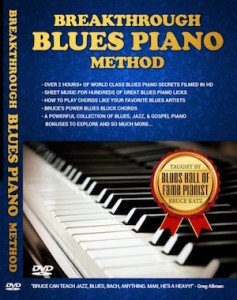 Do you want to learn more gospel and blues blocks chords?
Do you want to learn more gospel and blues blocks chords?- Want to quickly access a big collection of the best blues piano chords and progressions without having to spend years of your life trying to figure it out by yourself?
- Want to see all these chord written out in sheet music form so you can learn them more quickly
- Want to learn years of blues piano secrets from 2 world touring blues piano pros?
Then, the logical next step is to invest in a copy of The Breakthrough Blues Method.
Blues Hall Of Fame pianist Bruce Katz and I got together and created a course where we share years of our blues discoveries in a fun step by step method.
We look forward to sharing music with you further. If you have questions about this lesson, the Breakthrough Blues Method, easy blues piano techniques, or anything please leave a comment below.
We’re committed to helping you take your jazz and blues piano skills to the next level.
Blues Chord Progression Tutorial Video: 4 Tricks You Should Swipe
 Want to learn how to really spice up a blues chord progression? You’ve come to the right place.
Want to learn how to really spice up a blues chord progression? You’ve come to the right place.
In today’s free video lesson I’m going to teach 4 super sweet things you can do to decorate the first 4 bars of the blues.
This will help you play chorus after chorus of the blues and keep your listener entertained. Plus, these blues chord progression moves sound super cool!
Take a minute and watch this video. Hearing and seeing is everything! Then, scroll down and read the additional tips.
Important Blues Chord Progression Starter Points
 The first four bars of the blues are actually really malleable.
The first four bars of the blues are actually really malleable.
Essentially, that’s a fancy way of saying you can change the chords on them. The way that we change the chords on them will get you totally different sounding stylistic elements.
For example, we could play it one way and it will sound really kind of like down home, early blues.
We can play it another way, it will sound a little bit more like a Chicago blues or a Chicago shuffle.
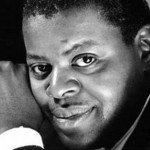 The third way we can play it, it could sound a lot more like Oscar Peterson or Wynton Kelly. Then the fourth way we play it, we could sound more like Charlie Parker or Barry Harris.
The third way we can play it, it could sound a lot more like Oscar Peterson or Wynton Kelly. Then the fourth way we play it, we could sound more like Charlie Parker or Barry Harris.
Read below to see what you can do…
How Smart Musicians Will Practice This
We are in the key of C for these examples here, but as a reminder, always apply what you learn in one key to other keys.
This is what frees you up at the keyboard here. As we go along, we’re going to get more an more harmonically sophisticated, but the first place we’re going to start here is just really kind of a “Gut Bucket” blues.
Blues Chord Progression Variation #1
What you’re going to do for the first four bars of the blues chord progression is we’re going to hang on the one chord.
Just hang on C7 the whole time. Simple stuff.
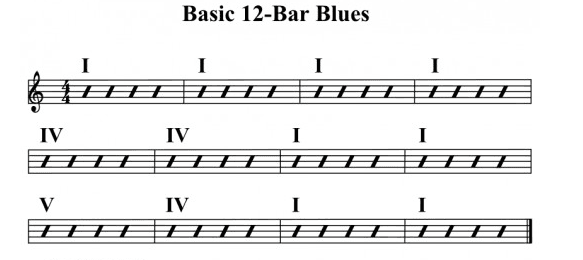
All you’re doing there is just hanging on the one chord. As long as you’ve got a good groove, there’s nothing wrong with just laying in the pocket and staying on that one chord.
That’s just concept number one. Just because we’re playing jazz doesn’t mean we can’t just groove and hang out on one chord.
Blues Chord Progression Variation #2
The next concept, similar to what we had in the first concept, but we’re going to do one small little variation. This variation is called “The Quick 4”.
Instead of doing this four bars of one, et cetera, et cetera, we’re going to do 1 bar of the I chord, 1 bar of the IV chord, then 2 bars again of the I chord.
The quick IV chord sort of resets the chord changes and a little bit different sounding. A little bit more sophisticated, we’re edging further forward here. That’s variation number two, “The Quick 4”.
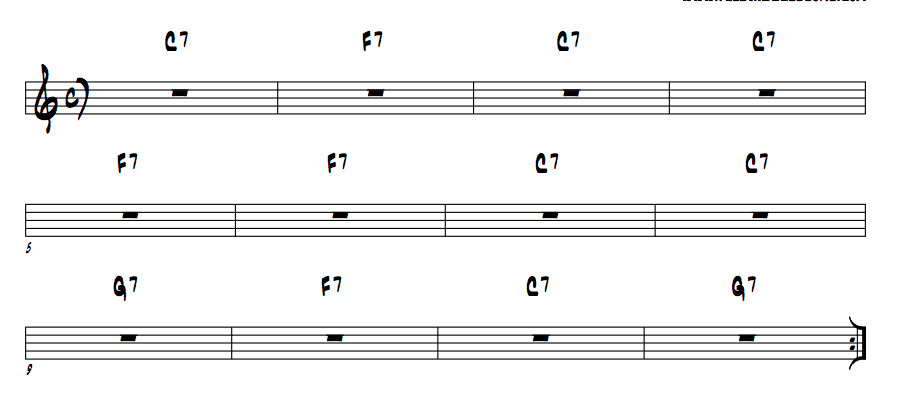
Blues Chord Progression Variation #3
All right, variation number three. This is considered a little bit more of a jazz blues chord progression now.
What you’re going to be doing here is you’re going to build off of what we saw in variation two, where we’re going to have that one chord in the beginning and then that four chord in bar 2, right?
We’re going to back to the I chord for bar 3, but instead of hanging out on the I chord for bar 4 we’re going to play a 2-5 chord progression in that bar instead.
This will set us up perfect to lead to the IV chord in bar 5.
As you heard in the video I was playing C7, F7, C7, and then playing the quick 2 5 chord progression in bar 4. And again since this is more of a jazz blues so I’m hipping up the chord changes and playing more jazzy voicings.
Again, getting more and more sophisticated as we go along.
 By the way, if you love all the sophisticated chords I show in this video I have a course that shows you how to play all of them and hundreds more.
By the way, if you love all the sophisticated chords I show in this video I have a course that shows you how to play all of them and hundreds more.
Plus, I also teach you how to use them inside real music that audiences love.
You can throw them into your playing today inside this program —> Premium Jazz Elite Membership Course.
Blues Chord Progression Variation #4
Our last variation for today’s free sample video is what we essentially call Parker blues changes.
What we’re going to do is we’re going to have that C7 in the very beginning, but now we’re going to do a quick two five into the vi chord.
Then, we’re going to do another two five into the 4 chord. Essentially we’re creating a huge chain of 2-5-1 chord progressions.
Simple kind of stuff here. We’re just two fiving into things, so we’ve got the C7, two five into the six chord, chromatically going down into a two five into the four chord. It continues on like that.
A lot more Bebop oriented with those particular chord changes.
I love jamming on those chords there, but I also love jamming on the first one, where we’re just hanging out on the one chord.
There are so many different ways of coloring in, bringing out your own musical taste throughout the blues.
As you saw, there’s just so many different ideas you can apply to just those first four bars of the blues.
More Bebop ideas, more Chicago based ideas, more Gut Bucket, down home one chord groove ideas. There’s so many cool things that you can do with the blues. We really just kind of scratched the surface here. It’s such a beautiful art form.
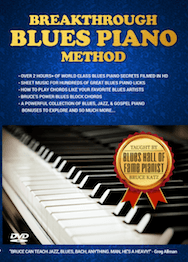 If you want to learn more of these re-harmonization techniques and all the different things you can do with the blues, I highly recommend that you pick up the Breakthrough Blues Piano Method.
If you want to learn more of these re-harmonization techniques and all the different things you can do with the blues, I highly recommend that you pick up the Breakthrough Blues Piano Method.
Hall of fame pianist Bruce Katz and I sat down and put years of the blues discoveries we made into a powerful course.
Bruce sits down and just teaches years and years of all the amazing stuff he’s learned as far as blues piano goes. Highly recommended course. You can get access to the Breakthrough Blues Method right here.
So, enjoy your practicing on these four little blues chord progression variations. Do you have questions on today’s lesson? Have questions blues? Anything else you want to talk about? Speak your mind and would love to hear from you.
Please leave a comment below. Happy to help!

